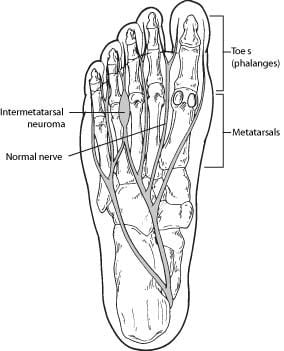Put Your Feet In Our Hands
Schedule an appointment
What Is a Neuroma?
A neuroma is a thickening of nerve tissue that may develop in various parts of the body. The most common neuroma in the foot is a Morton’s neuroma, which occurs between the third and fourth toes. It is sometimes referred to as an intermetatarsal neuroma. “Intermetatarsal” describes its location in the ball of the foot between the metatarsal bones. Neuromas may also occur in other locations in the foot.
 The thickening, or enlargement, of the nerve that defines a neuroma is the result of compression and irritation of the nerve. This compression creates enlargement of the nerve, eventually leading to permanent nerve damage.
The thickening, or enlargement, of the nerve that defines a neuroma is the result of compression and irritation of the nerve. This compression creates enlargement of the nerve, eventually leading to permanent nerve damage.
Causes
Anything that causes compression or irritation of the nerve can lead to the development of a neuroma. One of the most common offenders is wearing shoes that have a tapered toe box, or high-heeled shoes that cause the toes to be forced into the toe box.
People with certain foot deformities – bunions, hammertoes, flatfeet, or more flexible feet – are at higher risk for developing a neuroma. Other potential causes are activities that involve repetitive irritation to the ball of the foot, such as running or court sports. An injury or other type of trauma to the area may also lead to a neuroma.
Symptoms
If you have a Morton’s neuroma, you may have one or more of these symptoms where the nerve damage is occurring:
- Tingling, burning, or numbness
- Pain
- A feeling that something is inside the ball of the foot
- A feeling that there’s something in the shoe or a sock is bunched up
The progression of a Morton’s neuroma often follows this pattern:
- The symptoms begin gradually. At first they occur only occasionally, when wearing narrow-toed shoes or performing certain aggravating activities.
- The symptoms may go away temporarily by removing the shoe, massaging the foot, or by avoiding aggravating shoes or activities.
- Over time the symptoms progressively worsen and may persist for several days or weeks.
- The symptoms become more intense as the neuroma enlarges and the temporary changes in the nerve become permanent.
Diagnosis
To arrive at a diagnosis, the foot and ankle surgeon will obtain a thorough history of your symptoms and examine your foot. During the physical examination, the doctor attempts to reproduce your symptoms by manipulating your foot. Other tests or imaging studies may be performed.
The best time to see your foot and ankle surgeon is early in the development of symptoms. Early diagnosis of a Morton’s neuroma greatly lessens the need for more invasive treatments and may avoid surgery.
Non-surgical Treatment
In developing a treatment plan, your foot and ankle surgeon will first determine how long you’ve had the neuroma and evaluate its stage of development. Treatment approaches vary according to the severity of the problem.
For mild to moderate neuromas, treatment options may include:
- Padding. Padding techniques provide support for the metatarsal arch, thereby lessening the pressure on the nerve and decreasing the compression when walking.
- Icing. Placing an icepack on the affected area helps reduce swelling.
- Orthotic devices. Custom orthotic devices provided by your foot and ankle surgeon provide the support needed to reduce pressure and compression on the nerve.
- Activity modifications. Activities that put repetitive pressure on the neuroma should be avoided until the condition improves.
- Shoe modifications. Wear shoes with a wide toe box and avoid narrow-toed shoes or shoes with high heels.
- Medications. Oral nonsteroidal anti-inflammatory drugs (NSAIDs), such as ibuprofen, may be recommended to reduce pain and inflammation.
- Injection therapy. Treatment may include injections of cortisone, local anesthetics or other agents.
When Is Surgery Needed?
Surgery may be considered in patients who have not responded adequately to non-surgical treatments. Your foot and ankle surgeon will determine the approach that is best for your condition. The length of the recovery period will vary, depending on the procedure performed.
Regardless of whether you’ve undergone surgical or nonsurgical treatment, your surgeon will recommend long-term measures to help keep your symptoms from returning. These include appropriate footwear and modification of activities to reduce the repetitive pressure on the foot.
Contact Us
Send Us an Email
Our Location
Find us on the map
Hours of Operation
Our Regular Schedule
Clinton Foot & Ankle Clinic, PC
Monday:
9:00 am-5:00 pm
Tuesday:
9:00 am-4:00 pm
Jonesville Location
Wednesday:
9:00 am-3:30 pm
Thursday:
Closed
Friday:
Dates May vary Depending on surgery Schedule
9:00 am-12:00 pm
Saturday:
Closed
Sunday:
Closed